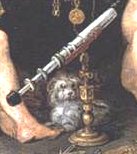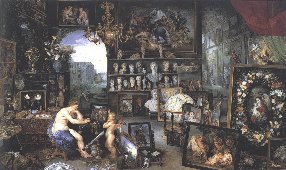A short note just arrived from Enrique Joven, concerning a recent talk he attended at the Instituto de Astrofísica de Canarias (IAC) by Dr. Paolo Molaro from the Osservatorio Astronomico di Trieste: “On the invention of the telescope and the paintings of Jan Brueghel”
Jan Brueghel depicted telescopes in four paintings spanning the period between 1609 and 1621. We have investigated the nature and the origin of these telescopes. An optical “tube” that appears in the painting dated 1608-1612, and probably reproduced also in a painting of the 1621, represents one the earliest documentation of a Dutch spyglass which could even tentatively attributed to Sacharias Janssen or Lipperhey, thus prior to those made by Galileo. Other two instruments made of several draw-tubes which appear in the two paintings of 1617 and 1618 are quite sophisticated for the period and we argue that may represent early examples of Keplerian telescopes.
Molaro is (of course) referring to Jan Brueghel the Elder (1568-1625): before this, I had only heard of the telescope in the series of paintings Brueghel executed with Rubens (which is now in the Prado), so I look forward to reading more about the other depictions of telescopes, particularly the earliest of the set. Here’s a tiny version of the 1617 painting:-
Just in case you haven’t got a CSI-style ‘infinite enhance‘ button in your web browser 🙂 , here’s a slightly more helpful close-up of the shiny multiple-draw-tube telescope depicted just to the left of the front centre:-

Incidentally, Molaro had done a similar presentation at IAU-UNESCO Symposium 260 in Paris a few days before (“Early telescopes in the paintings of Jan Brueghel”). To my surprise, Enrique mentioned that my Juan Roget theory was mentioned in one of Molaro’s slides: how nice to find out that people are actually listening!
Now that I have read about it, Google tells me about Pierluigi Selvelli’s poster session “On the Telescopes in the Painting of Bruegel ‘The Vision’” at the September 2008 “400 years of Astronomical Telescopes” conference at ESA/ESTEC in Noordwijk. Doubtless this all forms part of the same study, and I can’t wait to find out more…
Many artists of the time were fascinated by the telescope: Google also tells me that influential Rome-based painter Adam Elsheimer (1578-1610) corresponded with Galileo about telescopes through an intermediary.
As an aside, Vincent Ilardi’s “Renaissance Vision from Spectacles to Telescopes” mentions four works by Pieter Brueghel the Elder that depict spectacles, all apparently showing the spectacle-wearers in a negative light. Errrm… not a lot of people know that. 🙂
* * * * * *
Article update: following my post, Giancarlo Truffa very kindly emailed the HAstro-L mailing list with the names of all four Brueghel pictures studied by Paolo Molaro, together with links to online versions of them. And here they are…
- “Archduke Albert observing Mariemont Castle“, 1608-1611, Richmond (VA), Virginia Museum of Fine Arts
- “The Sense of Sight” (with Peter Paul Rubens), 1617, Madrid, Museo del Prado, 65 x 109 cm
- “The Sense of Sight and Smell“, c.1620, Madrid, Museo del Prado, 176 x 264 cm
- “Allegory of Air” (with Peter Paul Rubens), 1621, Paris, Musee du Louvre, 45 x 65 cm
Enjoy! 🙂

Well… given that Kepler devised his lens arrangement in 1611, it’s one of those things that’s certainly _possible_ (if a little unlikely).
As with most early telescope claims, I’ll wait to see the whole argument before getting too excited. 🙂
Hello Nick,
probably worth mentioning, that the painting shown above is the one dating from 1617, and it is not
the one dated 1608-1612, as might be incorrectly believed. A link to an image of that painting
would be of interest, should you have it.
Cheers, Rene
Hi Rene,
No sooner said than done! 🙂
Cheers, ….Nick Pelling….